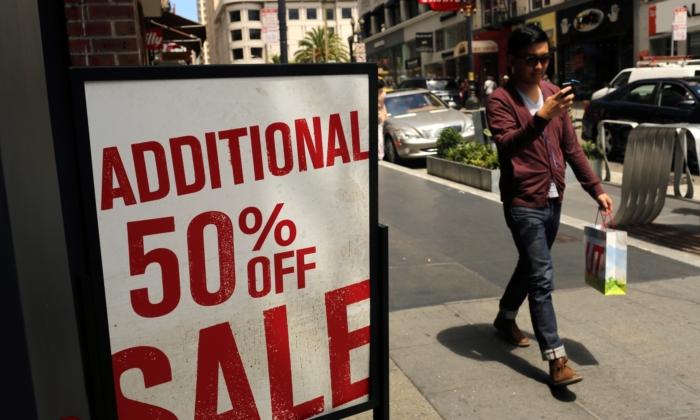BEA data show that the increase in real GDP was driven by gains in consumer spending, nonresidential fixed investment, private inventory investment, and federal, state, and local government spending.
In the April-to-June period, the GDP Price Index—a broad inflationary gauge of annualized prices of all goods and services listed in the GDP—slowed to 2.2 percent, down from 4.1 percent and below the market forecast of 3 percent.
Highlighting the resiliency of consumers in a rising-rate climate, personal consumption added to about half of the GDP print (1.12 percent). This was an immense decline from the first three months of 2023, when it soared by 2.79 percent. On a year-over-year basis, it came in at a better-than-expected 1.6 percent pace.
Business-fixed investment contributed 0.83 percent to the print, up from the negative 0.08 percent print in the first quarter. This was driven by higher spending on buildings and equipment.
Government consumption added 0.45 percent to the overall number, buoyed by greater federal, state, and local government spending.
Net trade trimmed about 0.12 percent from the final reading, while the change in private inventories was flat.
GDP sales—a measurement of final sales of domestic product—eased to 2.3 percent, down from 4.2 percent, and higher than economists’ expectations of 1.4 percent.
The Personal Consumption Expenditures (PCE) Price Index also slowed to 2.6 percent in the second quarter, down from 4.1 percent, according to the BEA’s advance estimate. Core PCE, which eliminates the volatile energy and food prices, eased to 3.8 percent, down from 4.9 percent and slightly under the projection of 4 percent.
Income and savings data were mixed in the second quarter.
Current-dollar personal income climbed by $236.1 billion, down from $278 billion in the first quarter. Real (inflation-adjusted) disposable personal income rose by 2.5 percent, down from 8.5 percent. The personal savings rate edged up to 4.4 percent from 4.3 percent.
The BEA’s second GDP estimate will be released on Aug. 30.
The Recession Debate
In recent weeks, many economists have shifted their recession forecasts.Federal Reserve Chair Jerome Powell told reporters during the post-Federal Open Market Committee (FOMC) policy meeting press conference on July 27 that staff economists have dropped their recession projection.

“So the staff now has a noticeable slowdown in growth starting later this year in the forecast, but given the resilience of the economy recently, they are no longer forecasting a recession,” Mr. Powell told reporters.
At the past several FOMC meetings, Fed economists had forecast a “mild recession” stemming from the fallout of the banking turmoil this past spring.
Since the U.S. central bank launched its quantitative tightening cycle, economists had warned that a recession was likely to happen because of higher borrowing costs, tighter credit conditions, and above-trend inflation. They also expected that unemployment would increase as a result of rate hikes. So far, this hasn’t happened.
The United States did experience a technical recession—back-to-back quarters of negative GDP growth—in the first half of 2022. But experts didn’t officially declare a downturn because of how strong the labor market was and still is.
But while officials anticipate either a soft landing or a sharp slowdown, there are still various signals indicating that a recession is on the horizon.
“We forecast that the U.S. economy is likely to be in recession from Q3 2023 to Q1 2024. Elevated prices, tighter monetary policy, harder-to-get credit, and reduced government spending are poised to dampen economic growth further,” Justyna Zabinska-LaMonica, the Conference Board senior manager of business cycle indicators, said in the report.
The yield curve inversion has been paramount for all of 2023.
Since last summer, the spread between the widely monitored two- and 10-year Treasury yields has hovered around negative 100 basis points. Plus, the three-month and 10-year spread, which is the Fed’s preferred recession indicator, has been stuck in negative territory, plummeting to as low as negative 180 basis points this past spring.
The two big banks have different outlooks.
But Goldman Sachs Research economists have lowered the chance of a recession in the next 12 months to 20 percent, down from the earlier estimate of 25 percent.
In its mid-year outlook, asset management firm GenTrust is sticking with its recession call “given the tightening of lending standards following the regional bank turmoil and ongoing restrictive monetary policy coming from the Fed.”





